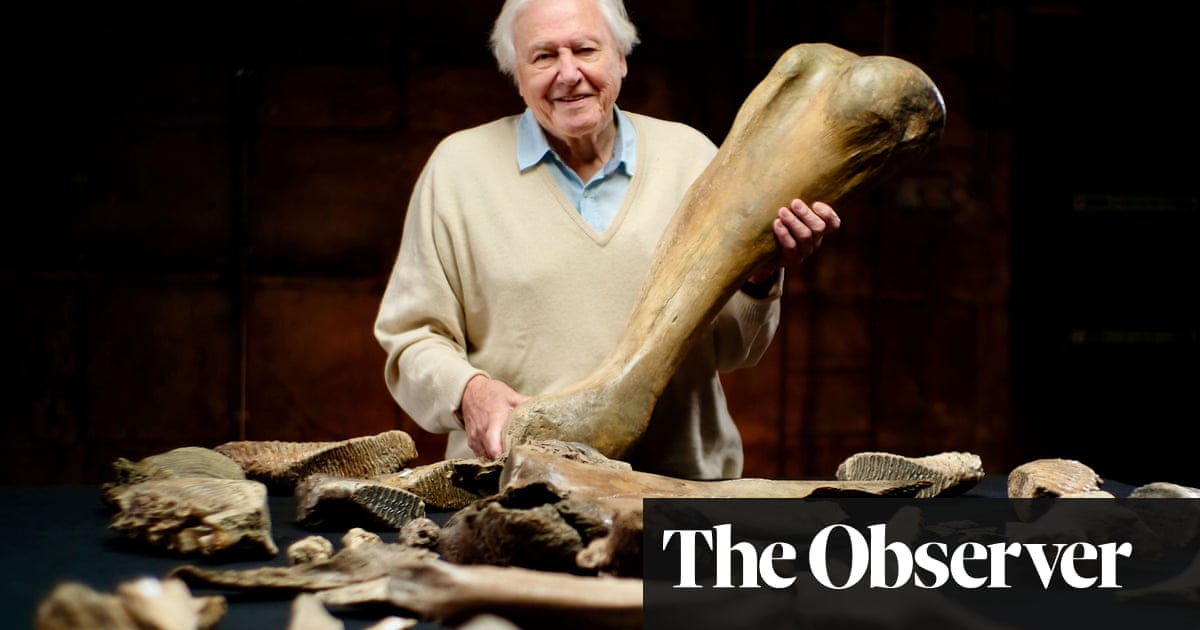
Leading British archaeologists and palaeontologists are warning that one of the nation’s most significant palaeolithic sites is under threat because there is not enough legislation to protect it.
They are calling for changes to the law amid fears that crucial evidence at a site in the Cotswolds could be lost to the UK for ever.
It was there that ice-age mammoths in an extraordinary state of preservation were discovered, sparking excitement in 2021 from Sir David Attenborough and other experts.
The extensive remains of at least one juvenile, two young adult and six fully grown adult mammoths that roamed 200,000 years ago were unearthed at Cerney Wick, near Swindon, along with tools used by Neanderthals, who probably hunted these enormous beasts.
Much more was expected to be found in further excavations because only a fraction of the vast site, a gravel quarry, had been explored.
Now, just as the foremost specialists from universities and national museums were preparing to return – having pursued necessary grants – they have found themselves barred by the quarry owner.
DigVentures, a team of archaeologists who give the public opportunities to participate in excavations, dug the site and coordinated the analysis and research with leading experts in 2021.
At the time co-founder Lisa Westcott Wilkins praised quarry owners Hills Quarry Products for allowing them as long as they needed, while the company itself said: “We will continue to support future investigations.”
Now the Observer has seen an 18 July email sent by Hills Quarry Products to DigVentures telling them that access to the site “will no longer be available” and that they are “formally requesting” the return of finds.
Westcott Wilkins told the Observer that her group was ultimately powerless to prevent the site being dug by somebody else, adding: “Better protection for these sites is paramount.”
She expressed frustration that any further finds could be taken away in the absence of legislation that would prevent this. “Export licences would be difficult to implement in this case because they do not cover bones unless they are altered by human hand or are clearly cultural items.” She said that other potential finds, including five tusks, are already visible within the layers.
There is disbelief among the archaeologists involved at the request to return the finds already uncovered. A tusk is on display in the Bristol Museum, with the rest in conservation. There had also been discussions about building a public outreach centre to display the rest of the collection.
Sources within the archaeological community told the Observer that their understanding was that the United Arab Emirates (UAE) may be linked to the latest developments, perhaps hoping to acquire further mammoth remains and Jurassic fossils for the new Natural History Museum Abu Dhabi. The UAE has been acquiring exhibits, reportedly buying a Tyrannosaurus rex skeleton for $31.8m in 2022.
The Observer approached the UAE Department of Culture and Tourism for comment. The company that owns the site, Hills Quarry Products, turned down a request for comment.
A drone photograph taken last Sunday suggests that the waterlogged quarry has been drained in advance of what some archaeologists fear will be a rushed search for finds.
Wilkins Westcott said: “We have five major universities as part of our research consortium because the site is so complex and difficult. That’s the expertise you need in order to do any justice to this.”
DigVentures was originally called in to lead the first detailed investigation of the site after a Neanderthal’s stone hand axe emerged. The initial discovery of the mammoth bones was made by amateur fossil hunters Sally and Neville Hollingsworth.
In 2021 the site was described by evolutionary biologist Prof Ben Garrod as “one of the most important discoveries in British palaentology”. The excavations also uncovered the remains of other ice-age giants, such as bison, elks and bears, as well as seeds, pollen and plant fossils – including extinct varieties – that could reveal a great deal about the environment then and how our Neanderthal ancestors lived in a period of prehistory about which little is known.
The exceptional discoveries were covered in a 2021 BBC One documentary, Attenborough and the Mammoth Graveyard, in which Sir David and Garrod joined archaeologists to film the excavation. The programme drew millions of viewers worldwide.
Garrod told the Observer this weekend: “When looking at something so complex – every grain of pollen or beetle wing case might tell us something – where finds range from the microscopic to, quite literally, mammoth in size, it takes a long-term, collaborative effort involving numerous stakeholders driven by expert knowledge and experience to fully understand the context.
“To lose a site like this now, just as it’s starting to reveal its secrets, would be devastating – not just in terms of knowing what happened there a quarter of a million years ago, but also for understanding how climate change will affect our environment both now and in the future.”
Prof Adrian Lister, the UK’s leading mammoth expert and a palaeobiologist at London’s Natural History Museum, said: “The site may demonstrate the final stages in the evolution of the woolly mammoth, one of the most iconic of ice-age species. We need a controlled excavation and for the remains to stay here, available for study.”
Historic England, one of the organisations that offered grants for the initial excavation, would not have the authority to control any new digging. Mel Barge, its inspector of ancient monuments in the south-west, said: “Historic England’s role is to protect our built heritage which also includes archaeological sites. Based on our current understanding, these remains are not protected as scheduled monuments because there is no structure on the site or clear evidence that these remains were shaped by human activity.”
Mike Heyworth, an archaeologist and former director of the Council for British Archaeology, said: “The problem is that it takes primary legislation and we just never get to the point of being a significant priority for government with limited parliamentary time… This puts the value of Cerney Wick at significant risk.”












